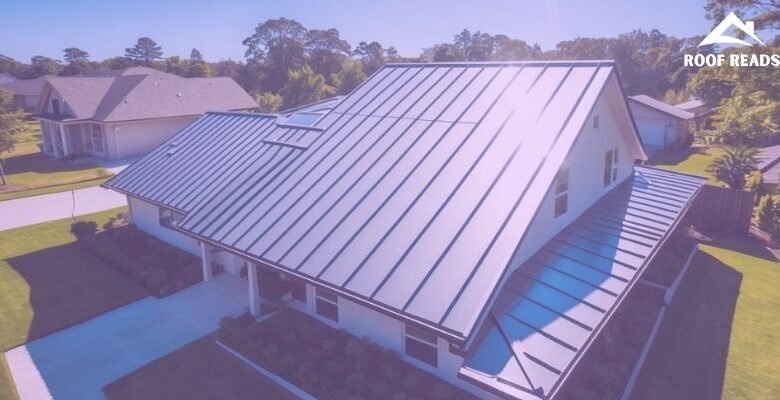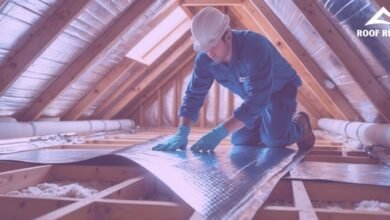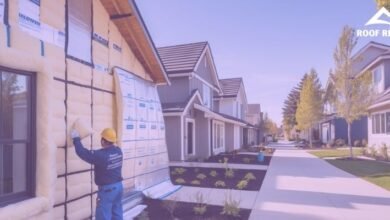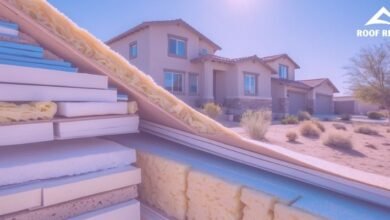How Long Will a Metal Roof Last: Lifespan Expectations and Factors

When considering a new roof for your home, longevity is often a top concern for homeowners. Metal roofing has gained popularity as a durable alternative to traditional asphalt shingles. Metal roofs have an impressive lifespan of 40-80 years depending on the specific material and system used, significantly outlasting the typical 15-20 year lifespan of standard asphalt shingle roofs.
The type of metal roofing system makes a big difference in how long it will last. Standing seam metal roofs, which feature panels locked together at the seams, typically last between 50 and 75 years. They can expand and contract freely with temperature changes. Screw-down panel metal roofs, while still durable, have a shorter lifespan of about 20-30 years.
Key Takeaways
- Metal roofs last 40-80 years compared to asphalt shingles’ 15-20 year lifespan, making them a long-term investment for homeowners.
- Standing seam metal roofs offer the longest lifespan (50-75 years) while screw-down panel systems typically last 20-30 years.
- Proper installation and regular maintenance can maximize a metal roof’s durability and performance over its lifetime.
How Long Does a Metal Roof Last?

Metal roofs stand out as one of the most durable roofing options available today. They offer impressive longevity compared to traditional roofing materials, making them a smart investment for homeowners looking for long-term solutions.
Average Lifespan of Metal Roofs
Most metal roofs last between 40 and 70 years with proper installation and maintenance. This is significantly longer than many other roofing materials. The specific type of metal plays a crucial role in determining lifespan:
- Steel Roofs: 40-60 years (galvanized)
- Standing Seam Metal: 50-75 years
- Aluminum Roofs: 50+ years
- Copper and Zinc: 70+ years (can last a century or more)
These estimates assume normal weather conditions and proper installation. Premium metal options like copper and zinc can exceed 70 years of service, sometimes lasting for generations. This extended lifespan makes metal roofing a one-time investment for many homeowners.
Factors Affecting Metal Roof Longevity
Several key factors influence how long a metal roof will last:
Material Quality: Higher-gauge metal and premium coatings increase durability and lifespan.
Installation Quality: Proper installation by experienced professionals prevents premature issues like leaks or loose panels.
Environmental Conditions: Extreme weather exposure (heavy snow, intense sun, salt air in coastal regions) can impact longevity.
Maintenance: Regular inspections and maintenance extend roof life. This includes clearing debris, checking fasteners, and addressing small issues before they become problems.
Roof Design: Proper ventilation and roof pitch help prevent moisture buildup and extend roof life.
Comparing Metal Roofs to Other Roofing Materials
Metal roofing outperforms most traditional materials in longevity:
| Roofing Material | Average Lifespan |
|---|---|
| Metal Roofing | 40-70+ years |
| Asphalt Shingles | 15-30 years |
| Wood Shingles | 20-40 years |
| Clay Tiles | 50-100 years |
| Concrete Tiles | 30-50 years |
While the initial cost of metal roofing is higher than asphalt shingles, the long-term value is superior. Traditional asphalt shingles typically require replacement 2-3 times during the lifespan of one metal roof.
Metal roofs also require less maintenance and offer better resistance to fire, wind, and impacts. They don’t crack, warp, or rot like some other materials can over time.
Types of Metal Roofs and Their Durability

Metal roofs come in various materials and styles, each offering different lifespans and performance characteristics. The type of metal and installation method you choose will significantly impact how long your roof will protect your home.
Steel and Aluminum Roofs
Steel roofing is the most common metal roofing material in the United States. Galvanized or coated steel typically lasts 40 to 60 years with proper maintenance. It offers excellent durability at a moderate price point.
Steel roofs resist fire, insects, and rot. They can withstand high winds and heavy snow loads when properly installed.
Aluminum roofs last about 50 years and perform exceptionally well in coastal areas. They don’t rust like steel can, making them ideal for saltwater environments.
Both steel and aluminum come in various profiles and colors. They’re lightweight yet strong, reducing structural requirements compared to heavy materials like slate or tile.
Durability Factors:
- Steel: 40-60 years
- Aluminum: 50+ years
- Weight: 1-3 pounds per square foot
- Wind resistance: Up to 140 mph
Copper and Zinc Roofs
Copper roofing offers unmatched longevity, often lasting 70+ years. Many copper roofs have protected buildings for over a century. The material develops a distinctive green patina over time that many homeowners find attractive.
Copper requires minimal maintenance and withstands extreme weather conditions. It’s naturally resistant to corrosion and doesn’t need protective coatings.
Zinc roofs share similar longevity to copper, with expected lifespans of 60-100 years. They develop a protective patina that self-heals minor scratches.
Both materials come at premium prices but offer exceptional long-term value:
Premium Metal Comparison:
| Metal Type | Lifespan | Maintenance | Cost |
|---|---|---|---|
| Copper | 70-100+ years | Minimal | Highest |
| Zinc | 60-100 years | Very low | High |
These metals are softer than steel, requiring careful installation by experienced professionals.
Standing Seam and Screw Down Metal Roofs
Standing seam metal roofs feature raised seams where panels join, keeping fasteners hidden and protected. This design allows for thermal movement while preventing water infiltration. They typically last 50+ years.
The concealed fastener system eliminates potential leak points. This makes standing seam roofs particularly suitable for low-slope applications.
Screw down (exposed fastener) metal roofs cost less initially but have shorter lifespans of 20-30 years. They use rubber gaskets on exposed screws that eventually deteriorate.
Installation Comparison:
- Standing seam: Concealed fasteners, superior weathertightness
- Screw down: Exposed fasteners, more maintenance required
- Panel expansion: Standing seam accommodates thermal movement better
Both systems work well when installed correctly, but standing seam offers superior long-term performance and fewer maintenance needs.
Protective Coatings and Their Role
Metal roof longevity depends heavily on protective coatings. These layers shield the metal from UV rays, moisture, and pollutants.
Galvanized steel has a zinc coating that sacrificially protects the steel from corrosion. Galvalume coating combines zinc and aluminum for enhanced corrosion resistance.
High-quality paint systems like Kynar 500 (PVDF) provide additional protection. These finishes resist fading, chalking, and peeling for 25-35 years.
Common Coating Types:
- Galvanized: Zinc coating (G60, G90)
- Galvalume: Zinc-aluminum alloy (AZ50, AZ55)
- Paint finishes: PVDF (Kynar 500), SMP, polyester
The coating thickness and quality directly impact roof durability. Premium coatings cost more initially but reduce maintenance and extend roof life. Warranties for paint systems typically range from 25-40 years depending on quality.
Key Factors Influencing Metal Roof Lifespan
Several crucial elements determine how long your metal roof will last. These factors work together to either extend or reduce the overall lifespan of your roofing investment.
Installation Quality
The expertise of your roofing contractor directly impacts how long your metal roof will serve you. Properly installed metal panels create a watertight seal that prevents moisture infiltration and structural damage.
Professional installers ensure correct fastener placement and appropriate panel overlap. These details prevent water seepage that could lead to premature rusting and deterioration.
Improper installation can create weak points where water collects, leading to corrosion. This is especially problematic around flashings, valleys, and transitions.
When selecting a contractor, look for those with specific metal roofing experience and proper certification. Ask potential installers about their training and request references from previous metal roof installations.
Climate and Environmental Conditions
Weather patterns in your region significantly affect metal roof durability. Coastal areas with salt spray exposure may experience accelerated corrosion on certain metal types.
Areas with frequent hailstorms might see more surface damage over time. However, quality metal roofing can withstand hail better than many alternative materials.
Extreme temperature fluctuations cause expansion and contraction that test fastening systems. Modern metal roofing systems are designed with this in mind, using clips that allow for movement.
UV exposure in sunny climates can fade certain finishes over time. High-quality paint systems with reflective properties help mitigate this issue and extend aesthetic appeal.
Proper Ventilation
A well-ventilated roof system prevents moisture buildup that can damage your metal roof from underneath. Without proper airflow, condensation can form on the underside of metal panels.
This trapped moisture accelerates corrosion and can damage underlying structural components. Good ventilation also helps regulate attic temperatures, reducing thermal stress on roofing materials.
Proper roof ventilation includes both intake vents (typically at the eaves) and exhaust vents (at or near the ridge). This creates a natural flow of air that removes heat and moisture.
An unventilated or poorly ventilated system can reduce metal roof lifespan by 20% or more. Professional roofers will assess your specific ventilation needs based on your home’s design and local climate conditions.
Maintenance and Maximizing Longevity
Proper maintenance is key to ensuring your metal roof reaches its full potential lifespan of 40-70 years. Regular care prevents common issues and helps identify problems before they become costly repairs.
Routine Maintenance and Inspections
Metal roofs need inspections at least twice a year – typically in spring and fall. Check for loose fasteners, sealant failures, and scratches in the protective coating.
Look closely at valleys and edges where debris often collects. Clear leaves, branches, and dirt to prevent moisture retention that can lead to corrosion.
Professional inspections every 2-3 years can catch problems homeowners might miss. Experts know where to look for early signs of trouble.
Document all inspections with photos to track changes over time. This creates a maintenance history that helps identify developing issues before they cause leaks or damage.
Preventing Wear and Tear
Trim overhanging branches that could scrape against the roof during storms. Even minor scratches can compromise protective coatings and lead to rust.
Use soft-soled shoes when walking on the roof to avoid denting the metal panels. Place your weight near supporting rafters whenever possible.
Clean gutters regularly to prevent water backup that can seep under metal panels. Clogged gutters are a common cause of edge damage and rot in the underlying structure.
Apply touch-up paint to scratches promptly. Small bottles of color-matched paint are available from most manufacturers for minor repairs.
Check flashing around chimneys, vents, and skylights yearly. These transition points are vulnerable to leaks if sealants crack or fail.
Maintenance Plans
Create a detailed maintenance schedule with seasonal tasks. Include gutter cleaning, debris removal, and inspection of critical areas.
Budget for professional maintenance every few years. The cost is minimal compared to premature replacement expenses.
Keep records of all maintenance performed, including receipts for any repairs. This documentation proves valuable for warranty claims and when selling your home.
Consider a maintenance contract with your installer. Many roofing companies offer annual service plans that include inspections, minor repairs, and cleaning.
Ask about manufacturer-approved cleaning products. Using harsh chemicals can damage protective coatings and void warranties.
When to Consider Roof Replacement
Watch for widespread rust that can’t be contained with spot treatments. Once corrosion spreads beyond small areas, replacement becomes more cost-effective than ongoing repairs.
Multiple leaks across different sections suggest systemic failure. If your roof requires frequent patch jobs, it’s time to evaluate replacement options.
Age matters even with metal roofs. After 40-50 years, advances in materials and energy efficiency might make upgrading economically sensible.
Check fasteners that have worked loose and can’t be properly secured. This often indicates the metal panels have expanded and contracted beyond their design limits.
Severe storm damage with multiple panels affected may warrant replacement rather than extensive repairs. Insurance often covers this type of damage.
Frequently Asked Questions
Metal roofs generate many questions from homeowners considering this durable option. These questions often focus on longevity, potential problems, and maintenance requirements that affect overall value.
What is the expected lifespan of a metal roof on residential property?
Metal roofs typically last between 40 and 70 years on residential properties. This extensive lifespan depends on several factors including the specific metal used and installation quality.
Premium materials like copper and zinc can last even longer, often exceeding 100 years with proper care. These high-end options represent some of the longest-lasting roofing materials available.
Regular maintenance can extend this lifespan even further, making metal roofing one of the most durable options for homeowners seeking long-term solutions.
What are some common issues associated with metal roofing?
Oil canning, which creates visible waviness in metal panels, represents a common aesthetic concern. This occurs due to metal expansion and contraction but doesn’t affect structural integrity.
Scratches and scuffs may develop over time, potentially leading to corrosion if the protective coating becomes damaged. Prompt touch-ups with manufacturer-approved products can prevent this issue.
Improper installation causes the majority of metal roof problems, including leaks at seams and fasteners. Hiring experienced installers specifically trained in metal roofing techniques significantly reduces these risks.
Does the presence of a metal roof increase the likelihood of lightning strikes?
Metal roofs do not attract lightning more than other roofing materials. This common misconception overlooks the physics of lightning, which strikes the highest point in an area regardless of material.
If lightning does strike a metal roof, the non-combustible nature of metal actually provides safety advantages. Metal disperses the electrical charge throughout the structure rather than concentrating it in one spot.
Many metal roofs can be grounded as an additional safety measure, directing electrical current safely into the ground if a strike occurs.
How does the durability of metal roofing compare to traditional shingle roofing?
Metal roofing significantly outperforms traditional asphalt shingles in longevity. While asphalt shingles typically last 15-30 years, metal roofs offer 40-70 years of protection.
Metal roofs resist common problems that plague shingle roofs, including rot, insect damage, and warping. This resistance to deterioration contributes to their extended lifespan.
The superior durability translates to fewer replacements over a building’s lifetime, offering long-term cost advantages despite higher initial installation expenses.
Can the longevity of metal roofing differ based on regional climates such as in Florida?
Coastal areas like Florida present unique challenges for metal roofs due to salt exposure and humidity. Specialized coatings and corrosion-resistant metals like aluminum perform better in these environments.
Hurricane-prone regions benefit from metal roofing’s superior wind resistance, with quality systems rated to withstand winds up to 140 mph. This provides significant advantages in storm-prone areas.
Proper installation with additional fasteners and reinforced edges helps metal roofs maintain their longevity even in harsh coastal climates.
What level of maintenance is required to preserve the condition of a metal roof?
Metal roofs require minimal maintenance compared to other roofing materials. Regular inspections twice yearly and after major storms help identify potential issues early.
Keeping the surface clean of debris and removing overhanging branches prevents damage and preserves protective coatings. Simple washing with mild soap and water removes most dirt accumulation.
Checking and replacing worn fasteners or sealants around flashing prevents water intrusion and extends roof life. This simple maintenance ensures optimal performance throughout the roof’s lifespan.




